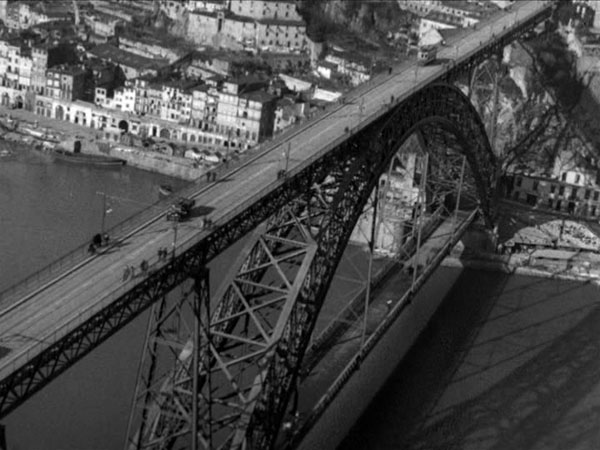Hello everyone, welcome to
Portuguese Film 101, I'm your lecturer for this module, for those of you who haven't had the pleasure I'm Dr. Jewesbury, yes, please sit down, hurry up, Derek please stop throwing things.
 Manoel de Oliveira, Douro, Faina Fluvial, Portugal 1931, still.
Manoel de Oliveira, Douro, Faina Fluvial, Portugal 1931, still.
We all know that 1931 produced some of the greatest port wines of the 20th century. What Portuguese filmmaker Manoel de Oliveira shows us in
Douro, Faina Fluvial (literally, "Douro, river of toil"), is not the picturesque postcard image of the river serenely snaking its way through the wine country, the
pipas carefully stacked on the
barca velhas, but the river of everyday labour, in the heart of the city of Porto. De Oliveira clearly displays the influence of the 'city symphony' filmmaking, most obviously Walter Ruttmann's 1927
Berlin: Symphony of a City, but also Dziga Vertov's 1929 masterpiece
Man With a Movie Camera. De Oliveira's filmic paean, however, is not so enamoured with the machine as these precedents; he shows us the human face of labour. He's also a skilled montagist, and he's absorbed a great deal from the new experiments in Soviet and European film narrative. We see the ugly, stern face of the policeman, shot from below, cut against the hard, round front of the shunting engine on the dockside; we see the straining muscles of the workers, the oxen heaving their carts up the docks, and the firing pistons inside the locomotive; and most endearingly, perhaps, we cut from the youth looking at his girl's backside as she bends to her work, to an upright iron bollard, communicating unambiguously his feelings to us.

What de Oliveira shows us is a day in the life of the Douro, a river that is the main vital artery in this hardworking city. It's salutary to think of this today as view the dereliction and desolation that has taken hold just a few streets behind the Ribeira, as one walks up to the Sé or the São Bento station. The film begins as it ends, with the blinking of a navigation beacon in the river. In between we see the ships come and go beneath the graceful arch of the Dom Luís Bridge, the sardines and the salt cod unloaded and sorted, the coal carried on head or back in large shallow baskets, work and (a little) relaxation, the dynamism and modernity and beauty of the city. Judging from the film itself, this was shot in late Spring or early Summer; perhaps late enough in the season for there to be no pipes of port visible on the Gaia quayside. At any rate the film was first shown in Lisbon in September 1931, where it was booed by its Portuguese audience. Why this might have been is a mystery, but perhaps they were bored with experimentalism, and with the concentration on the working class, and wanted something to match the melodramas pouring out of Hollywood by this time.
Personally, I find it humbling to think that the man who made this has only just left us. I have seen only a handful of his more recent films, but I plan on seeing more. He was awarded two lifetime achievement awards in Venice, simply because he refused to stop making films. Apologies that this is such a low resolution encode of the film, but if you ever come across the DVD release of his 2010 film
The Strange Case of Angelica (that's to say, the widely-acclaimed film he made 79 years after this one!) it's included as an extra there. This is the version that includes the new score that de Oliveira added in 1994 (another very good vintage; perhaps this was significant) and is 16½ minutes long. Now, dim the lights, please, and click the link below…
Manoel de Oliveira, Douro, Faina Fluvial, Portugal 1931, 16'22"
